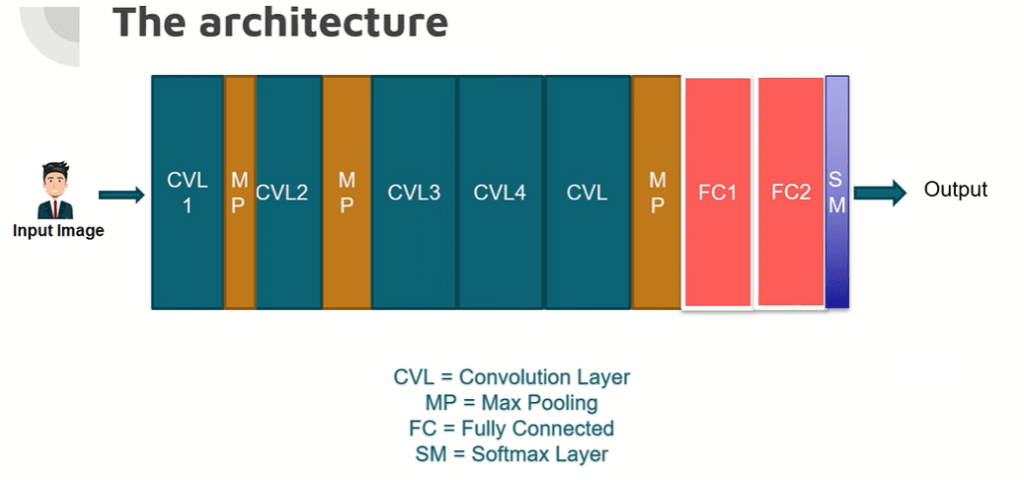Alexnet Architecture Explained | Introduction to Alexnet Architecture
 Naveen
Naveen- 0
In the field of artificial intelligence, image recognition has always been a challenging problem. Until the mid-2010s, traditional methods struggled to achieve the accuracy and efficiency needed for large-scale image classification tasks. However, in 2012, a breakthrough changed the game forever. AlexNet, a deep learning architecture that changed the field of computer vision.
AlexNet
AlexNet is a deep learning architecture and represents a variation of the convolutional neural network. It was originally proposed by Alex Krizhevsky during his research, under the guidance of Geoffrey E. Hinton, a prominent figure in the field of deep learning research. In 2012, Alex Krizhevsky participated in the ImageNet Large Scale Visual Recognition Challenge (ILSVRC2012) and utilized the AlexNet model, achieving an impressive top-5 error rate of 15.3%, surpassing the runner-up by more than 10.8 percentage points.

Architecture of AlexNet
- The AlexNet architecture consists of eight layers in total.
- The first five layers are convolutional layers.
- The sizes of the convolutional filters are 11×11, 5×5, 3×3, 3×3, and 3×3 for the respective convolutional layers.
- Some of the convolutional layers are followed by max-pooling layers, which help reduce spatial dimensions while retaining important features.
- The activation function used in the network is the Rectified Linear Unit (ReLU), known for its superior performance compared to sigmoid and tanh functions.
- After the convolutional layers, there are three fully connected layers.
- The network’s parameters can be tuned based on the training performance.
- The AlexNet can be used with transfer learning, utilizing pre-trained weights on the ImageNet dataset to achieve exceptional performance. However, in this article, we will define the CNN without using pre-trained weights, following the proposed architecture.

Key Components of AlexNet Architecture
Point 1 – Convolutional Neural Network (CNN): AlexNet is a deep Convolutional Neural Network (CNN) architecture designed for image classification tasks. CNNs are specifically suited for visual recognition tasks, leveraging convolutional layers to learn features from images hierarchically.
Point 2 – Architecture: AlexNet consists of eight layers, with the first five being convolutional layers and the last three being fully connected layers. The convolutional layers are designed to extract relevant patterns and features from input images, while the fully connected layers perform the classification based on those features.
Point 3 – ReLU Activation: Rectified Linear Unit (ReLU) activation functions are used after each convolutional and fully connected layer. ReLU introduces non-linearity, enabling the network to model more complex relationships in the data.
Point 4 – Max Pooling: Max pooling layers are applied after certain convolutional layers to reduce spatial dimensions while retaining essential features. This downsampling process helps reduce computation and controls overfitting.
Point 5 – Local Response Normalization: Local Response Normalization (LRN) is implemented to enhance generalization by normalizing the output of a neuron relative to its neighbors. This creates a form of lateral inhibition, making the network more robust to variations in input data.
Point 6 – Dropout: AlexNet uses dropout regularization during training, where random neurons are dropped out during forward and backward passes. This technique prevents overfitting and improves the model’s generalization performance.
Point 7 – Batch Normalization: Batch Normalization is applied to normalize the outputs of each layer within a mini-batch during training. It stabilizes and accelerates the training process, allowing for higher learning rates and deeper architectures.
Point 8 – Softmax Activation: The final layer of AlexNet uses the softmax activation function to convert the model’s raw output into class probabilities. This allows the network to provide a probability distribution over the possible classes for each input image.
Point 9 – Training and Optimization: AlexNet is trained using stochastic gradient descent with momentum. The learning rate is adjusted during training, and data augmentation techniques are applied to increase the diversity of the training dataset.
Point 10 – ImageNet Competition: AlexNet achieved significant success when it participated in the ImageNet Large Scale Visual Recognition Challenge (ILSVRC) in 2012. Its superior performance helped popularize deep learning and CNNs for image classification tasks.
Conclusion
AlexNet’s emergence in 2012 marked a pivotal moment in the world of deep learning and computer vision. Its innovative architecture, depth, and novel techniques like ReLU activation, dropout, and data augmentation set a new standard for CNN models. With its impressive performance and contributions to the ImageNet competition, AlexNet laid the groundwork for future advancements in the field, paving the way for a new era of artificial intelligence applications.
If you found this article helpful and insightful, I would greatly appreciate your support. You can show your appreciation by clicking on the button below. Thank you for taking the time to read this article.
Popular Posts
- From Zero to Hero: The Ultimate PyTorch Tutorial for Machine Learning Enthusiasts
- Day 3: Deep Learning vs. Machine Learning: Key Differences Explained
- Retrieving Dictionary Keys and Values in Python
- Day 2: 14 Types of Neural Networks and their Applications
